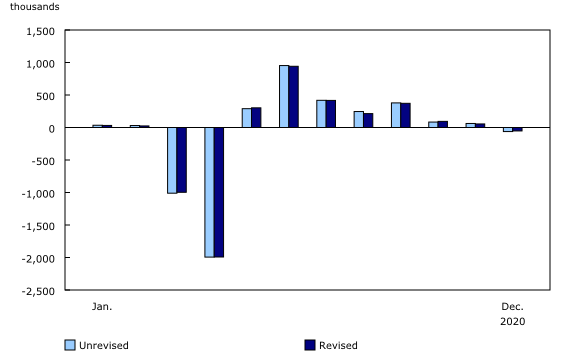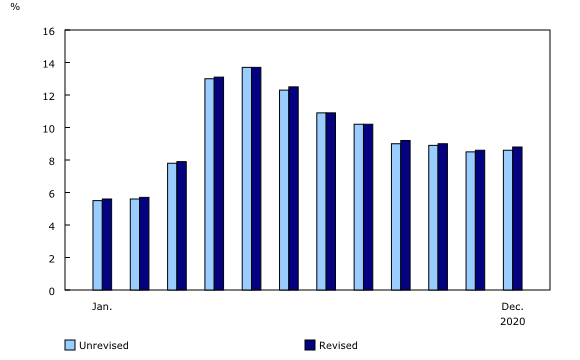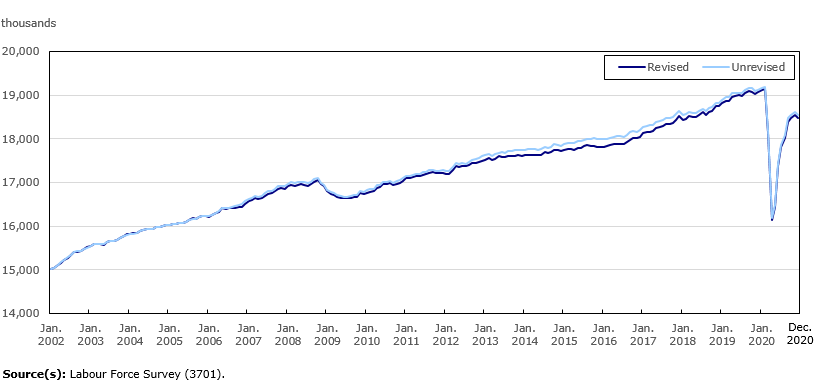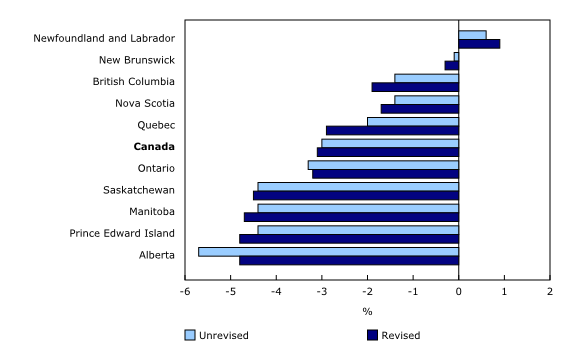Labour Force Survey: Revisions, 2001 to 2020
Archived Content
Information identified as archived is provided for reference, research or recordkeeping purposes. It is not subject to the Government of Canada Web Standards and has not been altered or updated since it was archived. Please "contact us" to request a format other than those available.
Released: 2021-01-25
Following each census cycle, Labour Force Survey (LFS) data are revised to ensure alignment with the most recently available population estimates, geographic boundaries, and occupation and industry classifications. This standard revision process—which has little impact on key labour market indicators such as employment and the unemployment rate—ensures that the LFS continues to paint a complete and accurate picture of labour market conditions.
Revised LFS series for the period from 2001 to 2020 are now available. Future LFS releases—including the release of January 2021 data on February 5—will be aligned with these revised series.
Revision has virtually no effect on LFS measures of the labour market impact of COVID-19
The historical revision of LFS data has minimal impact on the LFS estimates for the period from March to December 2020, during which the COVID-19 pandemic resulted in unprecedented changes to employment and the unemployment rate. For example, based on originally published data, employment declined by 1,994,000 (-11.0%) in April. Using revised data, that decline is 1,992,000 (-11.0%)—a difference of 1,600. The largest difference between the originally published and revised estimates was observed for August, when the originally published estimate was an increase of 246,000 (+1.4%), compared with a revised estimate of +214,000 (+1.2%).
Based on originally published estimates, as of December 2020, employment had increased by 2,368,000 (+14.6%) from a low point in April 2020. Using revised data, this employment change is +2,343,000 (+14.5%), a difference between the originally published and revised data of 25,000.
The historical revision has little impact on seasonally adjusted unemployment rates for 2020. The unemployment rate in May 2020 was originally published as 13.7%, the highest rate since comparable data became available in 1976, and did not change as a result of the revision. The current unemployment rate for December 2020 was revised from 8.6% to 8.8%.
Impact of the Labour Force Survey historical revision on national level labour market estimates since 2002
Over the period from 2002 to 2012, the impact of the historical revision on monthly employment estimates is very minor, reflecting the fact that LFS data for this period were previously revised following the 2011 Census. For the period from 2013 to 2018, employment was revised downward by an average of 0.7% (-130,000), while in 2019 and 2020, the revised estimates were an average of 0.3% (-64,000) lower than initially published.
Over the period from 2002 to 2019, both unemployment levels and rates were little changed as a result of the historical revision, with a maximum change in the monthly unemployment rate of 0.2 percentage points.
Impact in the provinces
The historical revision of LFS data has a minor impact on provincial employment trends. For example, when the pace of employment change from December 2019 to December 2020 was calculated using revised data, differences from the originally published estimates ranged from +0.8 percentage points in Alberta to -0.8 percentage points in Quebec.
Note to readers
More details on these revisions are available in the publication "The 2021 revisions of the Labour Force Survey (LFS)," as part of the Improvements to the Labour Force Survey (LFS) (71F0031X) series.
With today's release, the following data tables are available and have been revised from 2001 to 2020: 14-10-0017, 14-10-0019, 14-10-0020, 14-10-0021, 14-10-0022, 14-10-0023, 14-10-0026, 14-10-0027, 14-10-0028, 14-10-0029, 14-10-0030, 14-10-0031, 14-10-0032, 14-10-0033, 14-10-0034, 14-10-0035, 14-10-0036, 14-10-0037, 14-10-0042, 14-10-0043, 14-10-0044, 14-10-0045, 14-10-0048, 14-10-0049, 14-10-0050, 14-10-0051, 14-10-0054, 14-10-0055, 14-10-0057, 14-10-0058, 14-10-0059, 14-10-0060, 14-10-0063, 14-10-0064, 14-10-0191, 14-10-0193, 14-10-0194, 14-10-0195, 14-10-0196, 14-10-0197, 14-10-0198, 14-10-0199, 14-10-0200, 14-10-0285, 14-10-0286, 14-10-0287, 14-10-0288, 14-10-0289, 14-10-0291, 14-10-0292, 14-10-0310, 14-10-0355, 14-10-0374, 14-10-0375, 14-10-0376, 14-10-0377, 14-10-0378, 14-10-0379, 14-10-0380, 14-10-0381, 14-10-0382, 14-10-0383, 14-10-0384, 14-10-0385, 14-10-0386, 14-10-0387, 14-10-0388, 14-10-0389, 14-10-0390, 14-10-0391, 14-10-0392 and 14-10-0393.
New data tables have been created for all subprovincial areas based on the 2016 Census boundaries, and the data series is available for 2006 onward.
The remaining tables will be released on the website according to the following schedule:
January 26, 2021
Data tables: 14-10-0065, 14-10-0066, 14-10-0067, 14-10-0068, 14-10-0069, 14-10-0070, 14-10-0071, 14-10-0072, 14-10-0075, 14-10-0076, 14-10-0077, 14-10-0078, 14-10-0081, 14-10-0082, 14-10-0083, 14-10-0084, 14-10-0085, 14-10-0086, 14-10-0087, 14-10-0088, 14-10-0089, 14-10-0104, 14-10-0109, 14-10-0110, 14-10-0113, 14-10-0114, 14-10-0117, 14-10-0118, 14-10-0121, 14-10-0122, 14-10-0123, 14-10-0124, 14-10-0125, 14-10-0126, 14-10-0127, 14-10-0128, 14-10-0129, 14-10-0130, 14-10-0132, 14-10-0133, 14-10-0134, 14-10-0296, 14-10-0298, 14-10-0299, 14-10-0300 and 14-10-0301.
January 27, 2021
Data tables: 14-10-0302, 14-10-0303, 14-10-0304, 14-10-0305, 14-10-0306, 14-10-0308, 14-10-0309, 14-10-0315, 14-10-0316, 14-10-0317, 14-10-0318, 14-10-0319, 14-10-0320, 14-10-0327, 14-10-0335, 14-10-0340, 14-10-0342, 14-10-0359, 14-10-0363, 14-10-0364, 14-10-0365, 14-10-0366, 14-10-0367 and 14-10-0370.
The January 2021 Labour Force Survey estimates will be released on February 5, 2021.
Products
The article "The 2021 revisions of the Labour Force Survey (LFS)," which is part of Improvements to the Labour Force Survey (71F0031X), is now available.
Contact information
For more information, or to enquire about the concepts, methods or data quality of this release, contact us (toll-free 1-800-263-1136; 514-283-8300; STATCAN.infostats-infostats.STATCAN@canada.ca) or Media Relations (613-951-4636; STATCAN.mediahotline-ligneinfomedias.STATCAN@canada.ca).
- Date modified:





